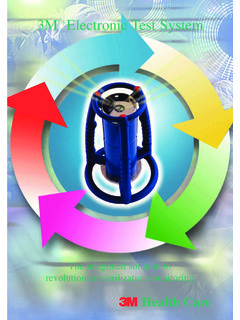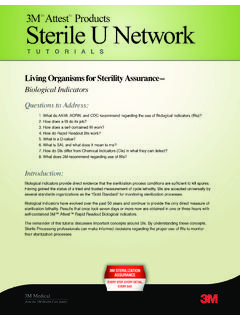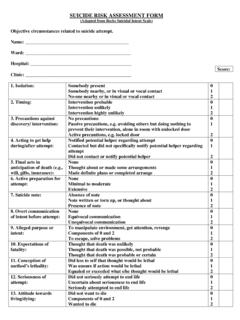Transcription of HIGHLIGHTS OF PRESCRIBING INFORMATION ...
1 1 HIGHLIGHTS OF PRESCRIBING INFORMATIONT hese HIGHLIGHTS do not include all the INFORMATION needed to use BROMSITE safely and effectively. See full PRESCRIBING INFORMATION for (bromfenac ophthalmic solution) topical ophthalmic administrationInitial US Approval: 1997--------------------------------INDI CATIONS AND USAGE---------------------------------Br omSite is a nonsteroidal anti-inflammatory drug (NSAID) indicated for the treatment of postoperative inflammation and prevention of ocular pain in patients undergoing cataract surgery. (1)-----------------------------DOSAGE AND ADMINISTRATION-------------------------- ---Instill one drop of BromSite to the affected eye twice daily (morning and evening) beginning 1 day prior to surgery, the day of surgery, and 14 days postsurgery.
2 ( )----------------------------DOSAGE FORMS AND STRENGTHS---------------------------Topi cal ophthalmic solution: bromfenac (3)-----------------------------------CO NTRAINDICATIONS------------------------- -----------None (4)-----------------------------WARNINGS AND PRECAUTIONS----------------------------- Slow or Delayed Healing ( ) Potential for Cross-Sensitivity ( ) Increased Bleeding Time of Ocular Tissue ( ) Keratitis and Corneal Effects ( ) Contact Lens Wear ( )-----------------------------------ADVE RSE REACTIONS------------------------------- -----The most commonly reported adverse reactions in 1-8% of patients were: anterior chamber inflammation, headache, vitreous floaters, iritis, eye pain and ocular hypertension. ( )To report SUSPECTED ADVERSE REACTIONS, contact Sun Pharmaceutical Industries, Inc.
3 At 1-800-406-7984 (toll free), or FDA at 1-800-FDA-1088 or 17 for PATIENT COUNSELING INFORMATION and FDA-approved patient labeling (Instructions for Use).Revised 04/2016 BROMSITE (bromfenac ophthalmic solution) PRESCRIBING INFORMATION :CONTENTS*1 INDICATIONS AND USAGE2 DOSAGE AND ADMINISTRATION Recommended Dosing Use with Other Topical Ophthalmic Medications3 DOSAGE FORM AND STRENGTHS4 CONTRAINDICATIONS5 WARNINGS AND PRECAUTIONS Slow or Delayed Healing Potential for Cross-Sensitivity Increased Bleeding Time of Ocular Tissue Keratitis and Corneal Reactions Contact Lens Wear6 ADVERSE REACTIONS Clinical Trial Experience8 USE IN SPECIFIC POPULATIONS Pregnancy Lactation Pediatric Use Geriatric Use11 DESCRIPTION12 CLINICAL PHARMACOLOGY Mechanism of Action Pharmacokinetics13 NONCLINICAL TOXICOLOGY Carcinogenesis.
4 Mutagenesis and Impairment of Fertility14 CLINICAL STUDIES Ocular Inflammation and Pain 16 HOW SUPPLIED/STORAGE AND HANDLING17 PATIENT COUNSELING INFORMATION *Sections or subsections omitted from the full PRESCRIBING INFORMATION are not listed. FULL PRESCRIBING INFORMATION :1 INDICATIONS AND USAGEBromSite (bromfenac ophthalmic solution) is indicated for the treatment of postoperative inflammation and prevention of ocular pain in patients undergoing cataract DOSAGE AND Recommended DosingOne drop of BromSite should be applied to the affected eye twice daily (morning and evening) 1 day prior to surgery, the day of surgery, and 14 days Use with Other Topical Ophthalmic MedicationsBromSite should be administered at least 5 minutes after instillation of other topical medications.
5 BromSite may be administered in conjunction with other topical ophthalmic medications such as alpha-agonists, beta-blockers, carbonic anhydrase inhibitors, cycloplegics, and mydriatics. 3 DOSAGE FORM AND STRENGTHST opical ophthalmic solution: bromfenac CONTRAINDICATIONSNone5 WARNINGS AND Slow or Delayed HealingAll topical nonsteroidal anti-inflammatory drugs (NSAIDs), including BromSite (bromfenac ophthalmic solution) , may slow or delay healing. Topical corticosteroids are also known to slow or delay healing. Concomitant use of topical NSAIDs and topical steroids may increase the potential for healing Potential for Cross-SensitivityThere is the potential for cross-sensitivity to acetylsalicylic acid, phenylacetic acid derivatives, and other NSAIDs, including BromSite (bromfenac ophthalmic solution) Therefore, caution should be used when treating individuals who have previously exhibited sensitivities to these Increased Bleeding Time of Ocular TissueWith some NSAIDs, including BromSite (bromfenac ophthalmic solution) , there exists the potential for increased bleeding time due to interference with platelet aggregation.
6 There have been reports that ocularly applied NSAIDs may cause increased bleeding of ocular tissues (including hyphemas) in conjunction with ocular surgery. It is recommended that BromSite be used with caution in patients with known bleeding tendencies or who are receiving other medications which may prolong bleeding Keratitis and Corneal ReactionsUse of topical NSAIDs may result in keratitis. In some susceptible patients, continued use of topical NSAIDs may result in epithelial breakdown, corneal thinning, corneal erosion, corneal ulceration or corneal perforation. These events may be sight threatening. Patients with evidence of corneal epithelial breakdown should immediately discontinue use of topical NSAIDs, including BromSite (bromfenac ophthalmic solution) , and should be closely monitored for corneal health.
7 Post-marketing experience with topical NSAIDs suggests that patients with complicated ocular surgeries, corneal denervation, corneal epithelial defects, diabetes mellitus, ocular surface diseases ( , dry eye syndrome), rheumatoid arthritis, or repeat ocular surgeries within a short period of time may be at increased risk for corneal adverse events which may become sight threatening. Topical NSAIDs should be used with caution in these patients. Post-marketing experience with topical NSAIDs also suggests that use more than 24 hours prior to surgery or use beyond 14 days postsurgery may increase patient risk for the occurrence and severity of corneal adverse Contact Lens WearBromSite should not be administered while wearing contact lenses.
8 The preservative in BromSite, benzalkonium chloride, may be absorbed by soft contact lenses. 6 ADVERSE REACTIONSThe following serious adverse reactions are described elsewhere in the labeling: Slow or Delayed Healing [see Warnings and Precautions ( )] Potential for Cross-Sensitivity [see Warnings and Precautions ( )] Increased Bleeding Time of Ocular Tissue [see Warnings and Precautions ( )] Keratitis and Corneal Reactions [see Warnings and Precautions ( )] Contact Lens Wear [see Warnings and Precautions ( )] Clinical Trial ExperienceBecause clinical trials are conducted under widely varying conditions, adverse reaction rates observed in the clinical trials of a drug cannot be directly compared to rates in the clinical trials of another drug and may not reflect the rates observed in clinical most commonly reported adverse reactions in 1-8% of patients were.
9 Anterior chamber inflammation, headache, vitreous floaters, iritis, eye pain and ocular hypertension. 8 USE IN SPECIFIC Pregnancy Risk SummaryThere are no adequate and well-controlled studies in pregnant women to inform any drug associated risks. Treatment of pregnant rats and rabbits with oral bromfenac did not produce teratogenic effects at clinically relevant doses. Clinical ConsiderationsBecause of the known effects of prostaglandin biosynthesis-inhibiting drugs on the fetal cardiovascular system (closure of ductus arteriosus), the use of BromSite during late pregnancy should be DataTreatment of rats with bromfenac at oral doses up to mg/kg/day (195 times a unilateral daily human ophthalmic dose on a mg/m2 basis, assuming 100% absorbed) and rabbits at oral doses up to mg/kg/day (3243 times a unilateral daily dose on a mg/m2 basis) produced no structural teratogenicity in reproduction studies.
10 However, embryo-fetal lethality, neonatal mortality and reduced postnatal growth were produced in rats at mg/kg/day, and embryo-fetal lethality was produced in rabbits at mg/kg/day. Because animal reproduction studies are not always predictive of human response, this drug should be used during pregnancy only if the potential benefit justifies the potential risk to the LactationThere are no data on the presence of bromfenac in human milk, the effects on the breastfed infant, or the effects on milk production; however, systemic exposure to bromfenac from ocular administration is low [see Clinical Pharmacology ( )]. The developmental and health benefits of breastfeeding should be considered along with the mother s clinical need for bromfenac and any potential adverse effects on the breast-fed child from bromfenac or from the underlying maternal Pediatric UseSafety and efficacy in pediatric patients below the age of 18 years have not been Geriatric UseThere is no evidence that the efficacy or safety profiles for BromSite differ in patients 65 years of age and older compared to younger adult DESCRIPTIONBromSite (bromfenac ophthalmic solution) is a sterile aqueous, topical NSAID, formulated in DuraSite for ophthalmic use.






